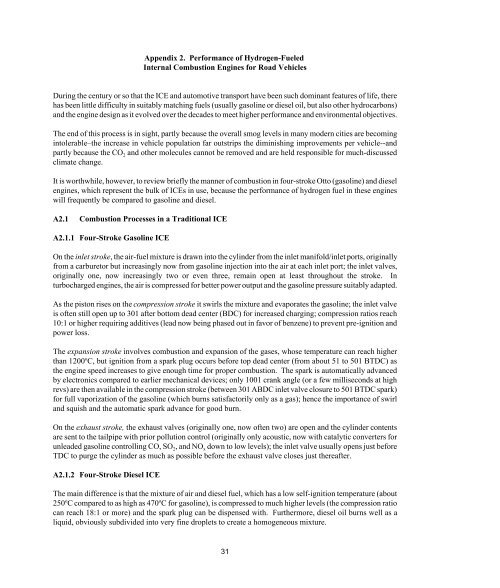Technology Status of Hydrogen Road Vehicles
Technology Status of Hydrogen Road Vehicles
Technology Status of Hydrogen Road Vehicles
Create successful ePaper yourself
Turn your PDF publications into a flip-book with our unique Google optimized e-Paper software.
Appendix 2. Performance <strong>of</strong> <strong>Hydrogen</strong>-Fueled<br />
Internal Combustion Engines for <strong>Road</strong> <strong>Vehicles</strong><br />
During the century or so that the ICE and automotive transport have been such dominant features <strong>of</strong> life, there<br />
has been little difficulty in suitably matching fuels (usually gasoline or diesel oil, but also other hydrocarbons)<br />
and the engine design as it evolved over the decades to meet higher performance and environmental objectives.<br />
The end <strong>of</strong> this process is in sight, partly because the overall smog levels in many modern cities are becoming<br />
intolerable–the increase in vehicle population far outstrips the diminishing improvements per vehicle--and<br />
partly because the CO 2 and other molecules cannot be removed and are held responsible for much-discussed<br />
climate change.<br />
It is worthwhile, however, to review briefly the manner <strong>of</strong> combustion in four-stroke Otto (gasoline) and diesel<br />
engines, which represent the bulk <strong>of</strong> ICEs in use, because the performance <strong>of</strong> hydrogen fuel in these engines<br />
will frequently be compared to gasoline and diesel.<br />
A2.1 Combustion Processes in a Traditional ICE<br />
A2.1.1 Four-Stroke Gasoline ICE<br />
On the inlet stroke, the air-fuel mixture is drawn into the cylinder from the inlet manifold/inlet ports, originally<br />
from a carburetor but increasingly now from gasoline injection into the air at each inlet port; the inlet valves,<br />
originally one, now increasingly two or even three, remain open at least throughout the stroke. In<br />
turbocharged engines, the air is compressed for better power output and the gasoline pressure suitably adapted.<br />
As the piston rises on the compression stroke it swirls the mixture and evaporates the gasoline; the inlet valve<br />
is <strong>of</strong>ten still open up to 301 after bottom dead center (BDC) for increased charging; compression ratios reach<br />
10:1 or higher requiring additives (lead now being phased out in favor <strong>of</strong> benzene) to prevent pre-ignition and<br />
power loss.<br />
The expansion stroke involves combustion and expansion <strong>of</strong> the gases, whose temperature can reach higher<br />
than 1200 o C, but ignition from a spark plug occurs before top dead center (from about 51 to 501 BTDC) as<br />
the engine speed increases to give enough time for proper combustion. The spark is automatically advanced<br />
by electronics compared to earlier mechanical devices; only 1001 crank angle (or a few milliseconds at high<br />
revs) are then available in the compression stroke (between 301 ABDC inlet valve closure to 501 BTDC spark)<br />
for full vaporization <strong>of</strong> the gasoline (which burns satisfactorily only as a gas); hence the importance <strong>of</strong> swirl<br />
and squish and the automatic spark advance for good burn.<br />
On the exhaust stroke, the exhaust valves (originally one, now <strong>of</strong>ten two) are open and the cylinder contents<br />
are sent to the tailpipe with prior pollution control (originally only acoustic, now with catalytic converters for<br />
unleaded gasoline controlling CO, SO 2, and NO x down to low levels); the inlet valve usually opens just before<br />
TDC to purge the cylinder as much as possible before the exhaust valve closes just thereafter.<br />
A2.1.2 Four-Stroke Diesel ICE<br />
The main difference is that the mixture <strong>of</strong> air and diesel fuel, which has a low self-ignition temperature (about<br />
250 o C compared to as high as 470 o C for gasoline), is compressed to much higher levels (the compression ratio<br />
can reach 18:1 or more) and the spark plug can be dispensed with. Furthermore, diesel oil burns well as a<br />
liquid, obviously subdivided into very fine droplets to create a homogeneous mixture.<br />
31













